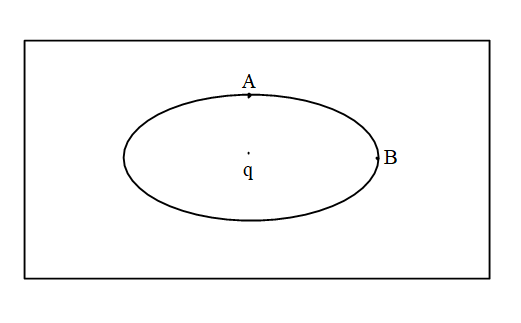
An ellipsoidal cavity is carved within a perfect conductor. A positive charge q is placed at the centre of the cavity. The points A and B are on the cavity surfaces as shown in the figure. Then:

A) Electric field near A in the cavity = Electric field near B in the cavity.
B) Charge density at A= charge density at B.
C) Potential at A=potential at B.
D) Total electric flux through the surface of the cavity is
Answer
142.2k+ views
Hint: The electric field is defined as the force per unit charge. Equipotential surfaces are defined as those surfaces which are having the same value of potential at every point on their surface. A cavity is a hollow volume inside a conductor.
Formula Used: The formula of the Gauss’s law is given by,
Where
Complete step by step answer:
It is given in the problem that there is an ellipsoidal cavity carved within a perfect conductor and a positive charge q is placed at the centre of the cavity and we need to tell which option is best suited for this problem.
Let us first calculate the value of the flux which flows through the conductor due to the presence of the charge.
The formula of the Gauss’s law is given by,
Where
The electric flux that flows through the surface of the conductor is equal to
The conductor carrying the charge is always an equipotential surface also the points A and B are at the surface of the conductor which means that the potential of points A and B are equal.
Since the electric flux through the surface of the conductor is
Therefore the correct option for this problem is option C and D.
Note: While solving problems related to flux use Gauss’s law. Students are advised to understand and remember the formula of Gauss’s law as it can help in solving these kinds of problems. The charge inside the cavity decides whether the flux will in inwards or outwards if the charge inside the cavity is unit positive charge then the flux will be outwards from the cavity of the conductor but if the charge is unit negative charge then the flus will be inward moving towards the cavity of the conductor.
Formula Used: The formula of the Gauss’s law is given by,
Where
Complete step by step answer:
It is given in the problem that there is an ellipsoidal cavity carved within a perfect conductor and a positive charge q is placed at the centre of the cavity and we need to tell which option is best suited for this problem.
Let us first calculate the value of the flux which flows through the conductor due to the presence of the charge.
The formula of the Gauss’s law is given by,
Where
The electric flux that flows through the surface of the conductor is equal to
The conductor carrying the charge is always an equipotential surface also the points A and B are at the surface of the conductor which means that the potential of points A and B are equal.
Since the electric flux through the surface of the conductor is
Therefore the correct option for this problem is option C and D.
Note: While solving problems related to flux use Gauss’s law. Students are advised to understand and remember the formula of Gauss’s law as it can help in solving these kinds of problems. The charge inside the cavity decides whether the flux will in inwards or outwards if the charge inside the cavity is unit positive charge then the flux will be outwards from the cavity of the conductor but if the charge is unit negative charge then the flus will be inward moving towards the cavity of the conductor.
Latest Vedantu courses for you
Grade 10 | MAHARASHTRABOARD | SCHOOL | English
Vedantu 10 Maharashtra Pro Lite (2025-26)
School Full course for MAHARASHTRABOARD students
₹33,300 per year
EMI starts from ₹2,775 per month
Recently Updated Pages
Uniform Acceleration - Definition, Equation, Examples, and FAQs

Difference Between Mass and Weight

Young's Double Slit Experiment Step by Step Derivation

Difference Between Circuit Switching and Packet Switching

JEE Main Participating Colleges 2024 - A Complete List of Top Colleges

JEE Main Maths Paper Pattern 2025 – Marking, Sections & Tips

Trending doubts
JEE Main 2025 Session 2: Application Form (Out), Exam Dates (Released), Eligibility, & More

JEE Main Exam Marking Scheme: Detailed Breakdown of Marks and Negative Marking

JEE Main 2025: Derivation of Equation of Trajectory in Physics

Electric Field Due to Uniformly Charged Ring for JEE Main 2025 - Formula and Derivation

Learn About Angle Of Deviation In Prism: JEE Main Physics 2025

Electric field due to uniformly charged sphere class 12 physics JEE_Main

Other Pages
JEE Advanced Marks vs Ranks 2025: Understanding Category-wise Qualifying Marks and Previous Year Cut-offs

JEE Advanced 2025: Dates, Registration, Syllabus, Eligibility Criteria and More

JEE Advanced Weightage 2025 Chapter-Wise for Physics, Maths and Chemistry

Degree of Dissociation and Its Formula With Solved Example for JEE

JEE Main 2025: Conversion of Galvanometer Into Ammeter And Voltmeter in Physics

Dual Nature of Radiation and Matter Class 12 Notes: CBSE Physics Chapter 11




